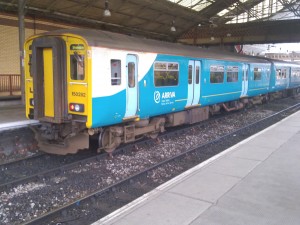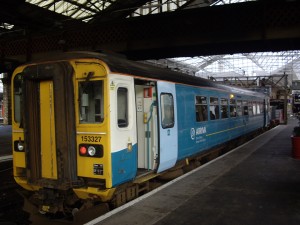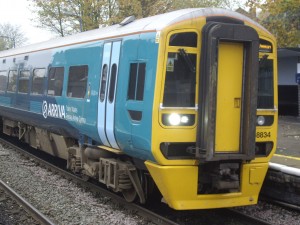There are a number of different types of passenger train used on the line between Crewe and Shrewsbury and the following notes are offered as a general guide without going into lots of engineering or train-spotters’ detail. If you really do fancy standing on the end of a draughty platform doing some ‘spotting’ there are far better sources of information in W H Smith’s on Crewe station, or from Amazon.
With the exception of the swish loco hauled express between Holyhead and Cardiff especially run for the Welsh Assembly all ATW trains are Standard Class only and consist of Diesel Multiple Units. This means they are powered by diesel engines, mounted under the carriage floors, and can run coupled together with one driver at the front and a conductor at the rear controlling the doors on several units. On ATW, a unit may consist of one, two or three carriages. Each unit has a six-digit number which is on the end of the unit below the drivers window and comprises a three-digit class number – such as 158 – followed by the number of the unit in that class. This explains and illustrates the various types that you can see at your local station.
Class 150

First appeared in 1984. On Arriva they are all two-coach sets. Each coach runs on two four-wheeled bogies and has a 285hp engine. Units can be coupled together to give four or six coach trains all accessible to the conductor. They have double sliding doors one third and two thirds along the coach; it is the only type on the line with this arrangement. Generally used on our stopping trains during the winter, but during the summer it is transferred to the Conwy Valley line for the tourist traffic. Sometimes pressed into service on the Cardiff – Manchester runs but mainly found on local services in South Wales.
Class 153.
A single carriage unit mounted on two four-wheeled bogies. One 285hp engine. Originally BR Regional Railways weren’t

going to have a single car unit, but realised that a number of rural routes didn’t provide enough traffic for a two car unit. Therefore they split a number of two car Class 155 units and adding an extra drivers cab. This explains why, at one end, passenger access is a little cramped, as the back wall for the drivers cab sticks out into the entrance vestibule. It may have been an afterthought, but it cut down on the number of vehicles that BR had to build, when the railways didn’t get the amount of subsidy it does now. As noted in the previous issue, we normally only see this on our line working the local service between May and December, when it is swapped for the Class 150 on the Conwy Valley line.
Class 158

A real workhorse, used all over ATW services. Some operators run the three-coach version but not ATW who have only two-coach sets. Introduced in 1989 they can be coupled together to form trains of six or more coaches with conductors and refreshment trolley staff having access to all passengers. Each coach runs on two bogies and has one diesel engine of 350 or 400hp. They are sometimes used on the local service if the usual set is not available, but can be seen regularly on two Crewe and Shrewsbury services; the 0950 from Crewe, which is a Holyhead to Birmingham International service, and 2053 Shrewsbury to Crewe. With the refurbishment of these sets they are receiving a new, darker livery.
Class 175.

Top of the ATW range, they were introduced in 1999, being acquired when ATW took over the North Wales services and are used on the Manchester – South Wales service. Both two and three car trains are in use and whilst trains can run in multiple, as they have different couplers and electrical systems they can’t run in multiple with any other diesel trains operated by ATW. Another difference they have with ATW’s other units is there is no gangway connection at the end of the trains. Whilst it gives the trains a neater appearance it does discourage forming longer trains. Each carriage has a single 450hp engine.
Compiled by
Don Rowlands & M R Bond

